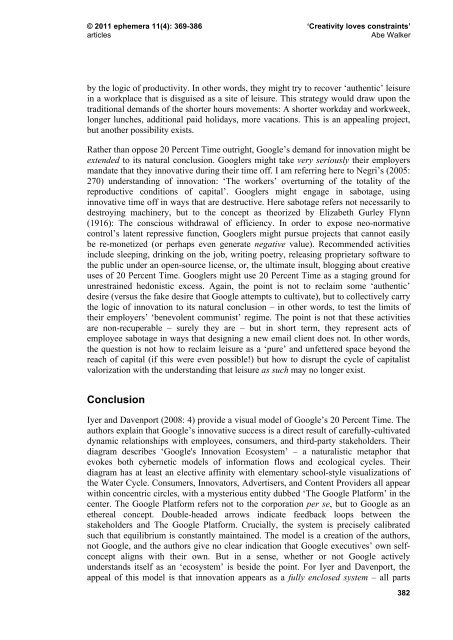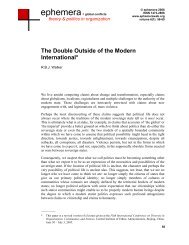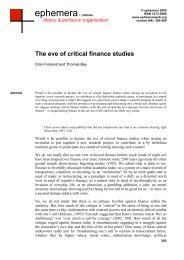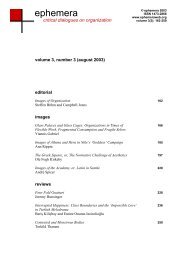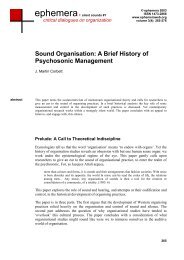Work, play and boredom - Ephemera
Work, play and boredom - Ephemera
Work, play and boredom - Ephemera
You also want an ePaper? Increase the reach of your titles
YUMPU automatically turns print PDFs into web optimized ePapers that Google loves.
© 2011 ephemera 11(4): 369-386 ‘Creativity loves constraints’<br />
articles Abe Walker<br />
by the logic of productivity. In other words, they might try to recover ‘authentic’ leisure<br />
in a workplace that is disguised as a site of leisure. This strategy would draw upon the<br />
traditional dem<strong>and</strong>s of the shorter hours movements: A shorter workday <strong>and</strong> workweek,<br />
longer lunches, additional paid holidays, more vacations. This is an appealing project,<br />
but another possibility exists.<br />
Rather than oppose 20 Percent Time outright, Google’s dem<strong>and</strong> for innovation might be<br />
extended to its natural conclusion. Googlers might take very seriously their employers<br />
m<strong>and</strong>ate that they innovative during their time off. I am referring here to Negri’s (2005:<br />
270) underst<strong>and</strong>ing of innovation: ‘The workers’ overturning of the totality of the<br />
reproductive conditions of capital’. Googlers might engage in sabotage, using<br />
innovative time off in ways that are destructive. Here sabotage refers not necessarily to<br />
destroying machinery, but to the concept as theorized by Elizabeth Gurley Flynn<br />
(1916): The conscious withdrawal of efficiency. In order to expose neo-normative<br />
control’s latent repressive function, Googlers might pursue projects that cannot easily<br />
be re-monetized (or perhaps even generate negative value). Recommended activities<br />
include sleeping, drinking on the job, writing poetry, releasing proprietary software to<br />
the public under an open-source license, or, the ultimate insult, blogging about creative<br />
uses of 20 Percent Time. Googlers might use 20 Percent Time as a staging ground for<br />
unrestrained hedonistic excess. Again, the point is not to reclaim some ‘authentic’<br />
desire (versus the fake desire that Google attempts to cultivate), but to collectively carry<br />
the logic of innovation to its natural conclusion – in other words, to test the limits of<br />
their employers’ ‘benevolent communist’ regime. The point is not that these activities<br />
are non-recuperable – surely they are – but in short term, they represent acts of<br />
employee sabotage in ways that designing a new email client does not. In other words,<br />
the question is not how to reclaim leisure as a ‘pure’ <strong>and</strong> unfettered space beyond the<br />
reach of capital (if this were even possible!) but how to disrupt the cycle of capitalist<br />
valorization with the underst<strong>and</strong>ing that leisure as such may no longer exist.<br />
Conclusion<br />
Iyer <strong>and</strong> Davenport (2008: 4) provide a visual model of Google’s 20 Percent Time. The<br />
authors explain that Google’s innovative success is a direct result of carefully-cultivated<br />
dynamic relationships with employees, consumers, <strong>and</strong> third-party stakeholders. Their<br />
diagram describes ‘Google's Innovation Ecosystem’ – a naturalistic metaphor that<br />
evokes both cybernetic models of information flows <strong>and</strong> ecological cycles. Their<br />
diagram has at least an elective affinity with elementary school-style visualizations of<br />
the Water Cycle. Consumers, Innovators, Advertisers, <strong>and</strong> Content Providers all appear<br />
within concentric circles, with a mysterious entity dubbed ‘The Google Platform’ in the<br />
center. The Google Platform refers not to the corporation per se, but to Google as an<br />
ethereal concept. Double-headed arrows indicate feedback loops between the<br />
stakeholders <strong>and</strong> The Google Platform. Crucially, the system is precisely calibrated<br />
such that equilibrium is constantly maintained. The model is a creation of the authors,<br />
not Google, <strong>and</strong> the authors give no clear indication that Google executives’ own selfconcept<br />
aligns with their own. But in a sense, whether or not Google actively<br />
underst<strong>and</strong>s itself as an ‘ecosystem’ is beside the point. For Iyer <strong>and</strong> Davenport, the<br />
appeal of this model is that innovation appears as a fully enclosed system – all parts<br />
382


